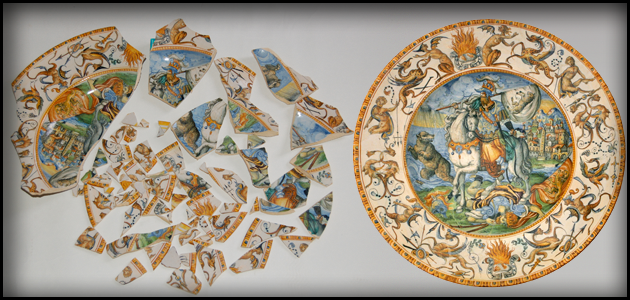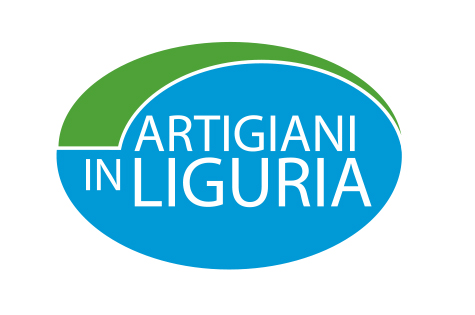The laboratory is specialized in terracotta, majolica pottery, porcelain and glass restoration, aiming to safeguard the great artistic and cultural heritage linked to these materials.
The interventions and operations follow a careful and scrupulous analysis pathway, that allows to determine different specific action to be taken, following the type, period and conservation conditions of the artwork.
Professionalism, skills and experience are the basis for a correct restoration intervention.
The restoration of a ceramic tile board: the retrieval of the warrior

Kept in Savona Town Picture Gallery, the 16th Century board portray a warrior, was part of a magnificent wall covering, made up by several eminent personalities of the time, embellishing the hall of Palazzo del Carretto (then Pavese, then Pozzobonello), located in via Quarda Superiore in Savona.
It seems that in XVI th century Italian pottery production there are no other examples of such importance. The workmanship is exquisite, and at least in Renaissance Ligurian art there are very few other examples of this same level. In 1857 the incautious removal carried out by the Mission Lazzarist Fathers, installed in the building also incorporating Bardolla and Gentile Ricci residences, caused the scattering of the different artwork’s pieces on the antiques market.
The four surviving images were probably part of a cycle of illustrious men. The subjects were taken from Factorum et dictorum memorabilium of Valerio Massimo, where we find Marcellus and Scipio, models of country love as they defended Rome at their own lives price. The extolling of this virtue sounded, at that time in Savona, as an anti-Genoese declaration. The other two left pictures, Marcellus and Scipio, are held in Turin (Palazzo Madama Royal Gallery) and Rome (Palazzo Barberini National Art Gallery).
Conservation conditions of the artwork
The board’s conservation condition was, in whole, acceptable, even if some tiles presented abrasions or enamel detachment on edges, and a split coinciding the foot part irremediably made the hero’s name illegible. An inappropriate distemper decoration revealed the remaking of the warrior’s bearded face.
The Restoration intervention
The board, made up by 45 majolica polychrome tiles, was put into a wooden frame. On the back a thick layer of plaster, tow and haircloth, was to join the ties. In the groove trellis was a thick layer of mortar to anchor the frame to the wall in the original location.
A previous restoration intervention had been made where the enamel was detached; the concentration of the completions (made with plaster and decorated with acrylic distempers) concerned the most part of the tiles, including the warrior’s face, reconstructed with bi-component filler and decorated with acrylic distempers on an airbrush background.
The first operation was to remove the wooden frame holding the artwork; then each single tile back was cleaned from the plaster, tow and haircloth layer by a pneumatic micro-scalpel, vibrating engraver, ultrasonic drill, medical scalpel and finally a light low atmosphere sandblast with crystal micro spheres.
The cleaning of tile’s back included the use of deionized water at vapor state, and non – aggressive detergent to remove the dusty and greasy layer covering the majolica surface; previous intervention has been mechanically removed using medical scalpel, ultrasonic drill and silicon rubber on micro drill in order to precisely outline original edges from the gaps.
Once the cleaning ended, the following step was to consolidate tile’s verso and breaks of the fragmented ties, by brushing them with hardening acrylic resins. Then, the fragments have been sticked using bi-component epossydic resin, and for enamel detachment epossydic glue infiltrations were carried out. Then cellulose filler and natural clay have been used for the gaps completion.
As for color remaking, a neutral background and acrylic distempers have been painted as subsequent step.
Pouncing paper has been useful to make the sketch of the missing recurrent decoration to come back to view. Charcoal pencil outline has then been used to re paint the missing decoration following the principle of intervention recognizability.
Under decision of Mr. Massimo Bartoletti, the Director responsible of local Ligurian Monuments and Fine Arts Department, previous intervention has been removed, as considered too fanciful and tardy; the blank has been restored with the mixture color, a hue lighter than original.
A transparent plexiglas stand (59×37.4×2.16 inches) has been chosen to support and keep the board; on a transparent back board (0.47 inch thickness) supporting prisms (one for each tile) have been sticked with mono component resin.
Once all tiles have been placed, the stand has been closed with a transparent panel, hang on the wall by an iron bracket in the new location of the Town Picture Gallery.
(Article by Barbara Checcucci, published on “Cose Antiche”, January 2008 – special thanks to Mr. M. Bartoletti, Mrs Mattiauda Savona Town Picture Gallery Director, Mr. G. Buscaglia of De Mari Foundation).
The plate from Este-Gonzaga Table Service

The restoration of the great plate from Este-Gonzaga Table Service
The concept of artwork restoration, especially for medieval enameled potteries, has in recent times evolved.
Till about twenty years ago, the common belief was that the intervention should be restricted to the “preservation” of the artwork. Ceramic and pottery restoration includes a wide range of handcrafts, from prehistoric pottery to contemporary ceramic art; a suitable intervention has to be carried out for each different type of artwork.
As regards medieval polychrome pottery, the trend was to fill the gaps using specific cellulose based plasters, a hue lighter than the original mixture; this allowed to unquestionably highlight the integration from the original.
The intervention did not consider a further color retouching.
Nowadays in restoration we also try to gratify the aesthetic side of the operation; pottery and ceramics exposed in a museum should be red in their integrity.
I had a great experience, some time ago: the opportunity to restore the great plate from the Este-Gonzaga table service, dated 1579, portraying Cyrus of Persia and owned by the Applied Art and Engravings Town Collection at Sforza Castle, Milan. This art work was part of a magnificent wedding table service, especially produced in the occasion Duke’s Alfonso d’Este 3rd marriage to Margherita Gonzaga.
This was probably the last and most wonderful season in Ferrara’s court life.
Alfonso spent part of his youth at Henry II French court, and come back to Italy to marry Lucretia de’ Medicis, whose entrance in Ferrara in February 1560 opened marvelous feasts, games, theater shows, carnival plays, giving to the city a magnificent image. The Duke loved music, and had several favorite artists, his own “protegés”. A special attention was devoted to the enrichment of Este Library, for whose Alfonso ordered the quest of all volumes published at the time of the invention and diffusion of the press, first of all Latin and Greek classics.
Alfonso had three legitimate wifes, and was left a widower twice, without any male heir. At Lucretia de’ Medicis death, in 1561, he married Barbara of Austria, Emperor Ferdinand 1st ‘s daughter, who died in 1572, then Margherita Gonzaga, daughter of William the Duke of Mantua and Monferrato, in 1579.
For this special wedding the wonderful table service was produced, whose emblem is the great plate, portraying Cyrus the Great, king of Persians capturing Astiage, king of the Medes.
Description
In the plate center, the scene representing Cyrus of Persia mounting a horse whilst he defeats Astiage, surrounded by other mythological figures.
Along the brim there is a grotesque decoration; in the middle the inscription ”Ardet Aeternum”
Before restoration
The artwork endured several different restoration interventions; it was broken up in various fragments, sticked by animal origin glues. The gaps and fractures integrations had been made using plaster and decorated by distempers. The great plate come to the laboratory with 4 fragments of the edge unglued.
Artwork cleaning and unstuck of the previous intervention
After a first surface cleaning, the previous integrations have been removed, using a scalpel.
The plate was then soaked in deionized water and ketonic solvent. An interesting detail are the holes on some fragments; this technique was in times past used to “sew” the different parts by iron or brass braces.
Sandblasting of the fragments
The fragments have been lightly sandblasted with glass micro crystals, in order to remove all traces of glue, eventually left on the fragments.
Joining of the fragments
The operation of joining the fragments together in the original places with adhesive tape helps to understand how to start the subsequent step of sticking.
Sticking
The fragments have been sticked by bi-component transparent colored resins (epossydic glues); once catalyzed (after about 24 hours) the exceeding resin has been removed using a scalpel and a micro drill.
Gaps and breaks filling
The filling has been made using bi-component and cellulose based plasters. After polishing a neutral acrylic distemper background has been spread by a sponge.
Chromatic range study and decoration completion
This phase allows to study, then execute, a retouch of the remade parts a hue lighter than original. It is painted with a brush; the choice in the case in question has been to retouch all remade zones, except a part of the grotesque decoration of the plate’s brim.
It is now possible to admire the great plate in its integrity, not having carried out unjustified or inappropriate painting restoration operations, in the total respect of the artwork.
(Article by Barbara Checcucci, published on “Cose Antiche”, November 2007)

